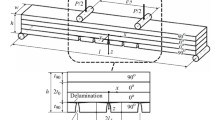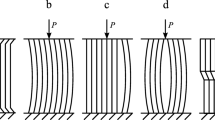Abstract
Knowledge of the three-dimensional stress distribution near a notch for a strain-hardening material in an elasto-plastic state is limited, to say the least. This experimental investigation is concerned with obtaining some insight concerning the three0dimensional elastoplastic stress distributions and the associated plastic-zone sizes. A notched-bar configuration (scaled-up Charpy specimen) subjected to flexure was selected for this purpose. The three-dimensional elasto-plastic stress distributions were determined along the plane of symmetry adjacent to the notch for two levels of applied bending moment.
The experimental-stress-analysis method utilizes the creep and frozen-stress characteristics of an epoxy resin when subjected to a thermal cycle whose maximum temperature is significantly less than the critical temperature of the model material. The resulting frozenstress-strain behavior is characterized by the generation of a nonlinear effective stress-strain curve. This effective stress-strain curve was generated by subjecting uniaxial tensile specimens to constant stress and the appropriate thermal cycle. Also, an effective birefringence-stress curve was obtained from these tensile specimens (calibration). Then the notched-bar configuration was subjected to the thermal cycle and an applied bending moment which would develop a plastic zone (determined by using a distortion-energy-yield criteria). The stress distributions were determined from photomechanical analysis of the slices removed from the model.
Similar content being viewed by others
References
Wells, A., andPost, D., “The Dynamic Stress Surrounding a Running Crack—A Photoelastic Analysis”,Proc. SESA,16, (1),69–92 (1957).
Dixon, J., “Stress Distribution Around a Central Crack in a Plate Loaded in Tension; Effect of Finite Width of Plate”,Jnl. Roy. Aeronaut. Soc. 64,141–145 (1960).
Dixon, J., “Some Studies of Elastic-Plastic Strain Distributions in Flat Bars Containing Holes and Notches”,DSIR Report No. PM 303, National Engineering Laboratory, East Kilbride, Glasgow (1961).
Kawata, K., “Analysis of Elasto-Plastic Behavior of Metals by Means of Photo-Elastic Coating Method,”J. Sci. Res. Inst., Tokyo,52,17–40 (1958).
Gerberich, W., “Stress Distribution About a Slowly Growing Crack Determined by Photoelastic-coating Method”,Experimental Mechanics,2 (12), (1962).
Mönch, E., and Loreck, R., “A Study of the Accuracy and Limits of Application of Plane Photoplasticity Experiments’, Proc. Intl. Symp. Photoelasticity, Macmillan (1963).
Thomson, R., and Frocht, M., “Further Work on Plane Elastoplastic Stress Distributions,” Proc. Intl. Symp. Photoelasticity, Macmillan (1963).
Frocht, M., and Cheng, Y., “An Experimental Study of the Laws of Double Refraction in the Plastic State in Cellulose Nitrate-Foundations for Three-Dimensional Photoplasticity”, Proc. Internatl. Symp. Photoelasticity, Macmillan (1963).
Hunter, A. R., and Schwarz, “Development and Application of a Photoelasto-Plastic Method to Study Stress Distributions in Vicinity of a Simulated Crack,” NASA CR 655 (December 1966).
Kuske, A., “Multiphase Theory of Plastics,”Experimental Mechanics,2 (9),278–280 (1962).
Hunter, A. R., Wilshaw, R., and Kyser, E., “Photoelasto-Plastic Stress Distributions in Notched Bar Configuration”, LMSC-6-78-68-24 (August 1968).
Ramberg, W., and Osgood, W., “Description of Stress-Strain Curves by Three Parameters”, NACA TN 902 (July 1943).
Hunter, A. R., “Computerized Data Reduction System For Photoelastic Analysis”, LMSC-6-78-68-16 (February 1968).
Wilshaw, T. R., Rau, C. A., and Tetelman, A. S., “A General Model to Predict the Elastic-Plastic Stress Distribution and Fracture Strength of Notched Bars in Plane Strain Bending”, J. Eng. Fracture Mech. 1 (1968).
Neuber, H., “Theory of Notch Stresses: Principles for Exact Calculation of Strength with Reference to Structural Form and Material”, AEC TR 45–47 (1968).
Hill, R., Mathematical Theory of Plasticity, Oxford, London (1950).
Rice, J. R., and Rosengren, G. F., “Plane Strain Deformation near a Crack Tip in a Power Law Hardening Material”, Brown University Rep. (July 1967).
Author information
Authors and Affiliations
Rights and permissions
About this article
Cite this article
Hunter, A.R. Photoelasto-plastic analysis of notched-bar configuration subjected to bending. Experimental Mechanics 10, 281–287 (1970). https://doi.org/10.1007/BF02320679
Issue Date:
DOI: https://doi.org/10.1007/BF02320679




